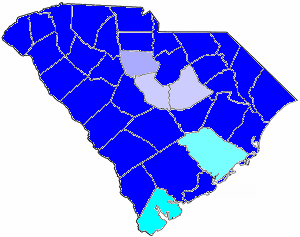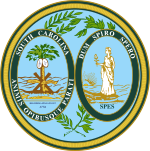
Coleman Livingston Blease was an American politician of the Democratic Party who served as the 89th governor of South Carolina from 1911 to 1915 and represented the state in the United States Senate from 1925 to 1931. Blease was the political heir of Benjamin Tillman. He led a political revolution in South Carolina by building a political base of white textile mill workers from the state's upcountry region. He was notorious for playing on the prejudices of Poor Whites to gain their votes and was an unrepentant white supremacist.

Prior to 1865, the Governor of South Carolina was chosen by the General Assembly. The Constitution of South Carolina provided for the voters of South Carolina to choose the governor; James Lawrence Orr was the first elected governor of South Carolina. The following is a list of gubernatorial election results for the state of South Carolina:

The 1922 South Carolina gubernatorial election was held on November 7, 1922, to select the governor of the state of South Carolina. Thomas Gordon McLeod won the Democratic primary and ran unopposed in the general election becoming the 95th governor of South Carolina.

The 1934 South Carolina gubernatorial election was held on November 6, 1934, to select the governor of the state of South Carolina. Olin D. Johnston won the contested Democratic primary and ran unopposed in the general election becoming the 98th governor of South Carolina.

The 1890 South Carolina gubernatorial election was held on Tuesday November 4, to elect the governor of South Carolina. Ben Tillman was nominated by the Democrats and easily won the general election against A.C. Haskell to become the 84th governor of South Carolina.

The 1896 South Carolina gubernatorial election was held on November 3, 1896 to select the governor of the state of South Carolina. William Haselden Ellerbe won the Democratic primary and easily won the general election to become the 86th governor of South Carolina.

The 1898 South Carolina gubernatorial election was held on November 8, 1898 to select the governor of the state of South Carolina. Governor William Haselden Ellerbe won the Democratic primary and ran unopposed in the general election to win a second term as governor.

The 1900 South Carolina gubernatorial election was held on November 6, 1900 to select the governor of the state of South Carolina. Governor Miles Benjamin McSweeney won the Democratic primary and ran unopposed in the general election to win a term for governor in his own right.

The 1906 South Carolina gubernatorial election was held on November 6, 1906, to select the governor of the state of South Carolina, United States. Martin Frederick Ansel won the Democratic primary and ran unopposed in the general election to become the 89th governor of South Carolina.

The 1908 South Carolina gubernatorial election was held on November 3, 1908, to select the governor of the state of South Carolina. Governor Martin Frederick Ansel faced state senator Coleman Livingston Blease in the Democratic primary and emerged victorious to win a second two-year term as governor.
The 1912 South Carolina gubernatorial election was held on November 5, 1912, to select the governor of the state of South Carolina. Governor Coleman Livingston Blease won the Democratic primary. As South Carolina was utterly dominated by the Democratic Party, he faced no significant opposition in the general election.

The 1914 South Carolina gubernatorial election was held on November 3, 1914, to select the governor of the state of South Carolina. Richard Irvine Manning III emerged from the crowded Democratic primary to win in the runoff and overwhelmingly won the effectively one-party state's general election to become the 92nd governor of South Carolina.

The 1916 South Carolina gubernatorial election was held on November 7, 1916, to select the governor of the state of South Carolina. Governor Richard Irvine Manning III faced a strong challenge from former governor Coleman Livingston Blease in the Democratic primary, but Manning won a second two-year term as governor.
Claudius Cyprian Featherstone was a lawyer and judge in South Carolina. He was born in Laurens County and educated at the Patrick Military Institute. Afterwards, he undertook the study of law in Anderson where he then practiced law for a year. Featherstone returned to Laurens and practiced law there for over twenty years. While in Laurens on October 10, 1893, Featherstone married Lura Lucretia Pitts. Featherstone entered the 1910 South Carolina gubernatorial contest as the conservative and prohibitionist candidate. He lost the race to Coleman Livingston Blease by just over 5,000 votes because Blease was able to successfully galvanize the textile workers and tenant farmers for his candidacy. In 1911, Featherstone practiced law in Greenwood until 1923 when he was elected to be the judge of the Eighth Judicial Circuit. He served as a judge until his death in 1945.

The 1914 United States Senate election in South Carolina was held on November 3, 1914 to select the U.S. Senator from the state of South Carolina. It was the first election in South Carolina in which the voters were able to choose the candidate in the general election. Incumbent Democratic Senator Ellison D. Smith won the Democratic primary and defeated nominal opposition in the general election to win another six-year term.

The 1930 South Carolina United States Senate election was held on November 4, 1930, to select the U.S. Senator from the state of South Carolina. Incumbent Democratic Senator Coleman Livingston Blease was defeated in the Democratic primary by James F. Byrnes. He was unopposed in the general election to win a six-year term.

The 1918 South Carolina United States Senate election was held on Tuesday, November 5, simultaneously with the special senate election to elect the United States Senator for a six-year term from South Carolina. Nathaniel B. Dial won the Democratic primary and was unopposed in the general election to win the six-year term to the Senate.

The 1924 South Carolina United States Senate election was held on November 4, 1924, to select the U.S. Senator for a six-year term from the state of South Carolina. Coleman Livingston Blease won the Democratic primary and was unopposed in the general election to win the six-year term to the Senate.

The 1913 South Carolina United States Senate election was held on January 28, 1913, when the South Carolina legislature met and unanimously ratified the results of the August 27, 1912 primary. Incumbent Senator Ben Tillman was re-elected to a fourth term in office.

The 1897 South Carolina United States Senate election was a unanimous election of the Democratic nominee on January 26, 1897 to select the U.S. Senator from the state of South Carolina. The Democratic primary election was held on August 26, 1896 and September 9. Prior to the ratification of the 17th Amendment to the United States Constitution, U.S. Senators were elected by the state legislature and not through the direct election by the people of the state. However, the Democratic Party of South Carolina organized primary elections for the U.S. Senate beginning in 1896 and the General Assembly would confirm the choice of the Democratic voters. Conservative Democratic Joseph H. Earle won the Democratic primary and was elected by the General Assembly for a six-year term.







